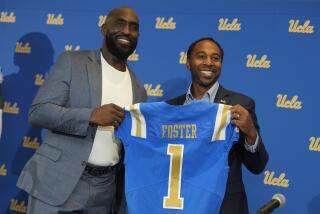State Cuts Could Reach Tenured Faculty at CSUN : Priorities: Eighteen sports teams cost $3.8 million annually. Critics say the school should consider dropping one of them.
- Share via
The most heated debate on the Cal State Northridge campus these days is not over the ethics of abortion, the practicality of fusion power or the origin of man.
Rather, it is the propriety of spending $3.8 million on the 18 sports teams that make up the CSUN athletic department. In hallways, over lunch and in their offices, professors are arguing that some or all of that money should be spent on academic disciplines.
“Is it important that we have intercollegiate football when we have USC and UCLA producing teams?” Faculty President Louise Lewis asked. “We don’t have a snowball’s chance in hell of beating them.”
Faculty critics said the school should at least consider dropping one of its sports, such as football, the most expensive, at an annual cost of about $350,000.
Growing anxiety over the size of cuts in the state budget for higher education has turned up the intensity of such arguments, which have been heard off and on for several years.
It started with CSUN President James W. Cleary’s 1989 decision to have the school compete in the NCAA Division I, rather than the more modest, and less costly, Division II.
And with proposed state budget cuts of between 8% and 11%, the debate is not likely to die down soon. The school faces cutbacks of historic proportions, with more than a third of the teaching staff facing layoffs in the fall.
Team coaches, however, are not targeted for layoffs, even though they are not tenure-track instructors.
Cuts to the school’s academic departments are estimated to total $8.4 million--mostly in salaries--out of what would have been a $78-million budget for next year.
“There is someplace for athletics, but I don’t think we should be spending that kind of money when we are not spending it on the arts,” said Philip Handler, dean of the School of the Arts.
Bob Hiegert, CSUN’s director of athletics, said that kind of campus talk is understandable but misguided.
“People are frightened; they are scared of their own positions,” Hiegert said. “But if you take away all the money we are rumored to have, there is not enough to solve even one of the school’s problems. And after you shut down athletics, who is next?”
Hiegert said that academic departments would turn on each other if there were no athletic department to criticize.
Faculty members say they are especially upset that the CSUN Foundation--a private, nonprofit fund-raising group--has agreed to give its largest annual donation, $500,000, to fund athletics for 10 years.
Jerry Luedders, chairman of the CSUN music department, said he has stopped asking for donations from the foundation because he has been turned down so many times. Budget cuts to his $2-million annual budget are forcing him to dismiss instructors who teach flute, oboe, clarinet, bassoon, trumpet, French horn, trombone, viola, string bass and organ.
“I have always believed that athletics and music do the same things for a campus,” Luedders said. “They are constantly in the public eye, they create strong relationships with alumni and are strong fund-raisers on campus.”
But Luedders believes that the two departments are treated much differently, even though they serve about the same number of students. For one thing, athletics gets about twice as much money.
That means student musicians must pay more for out-of-pocket expenses such as transportation, uniforms and equipment than do their counterparts on athletic teams, Luedders said.
Besides that, “athletics doesn’t prepare someone for a profession,” Luedders said. “If you look at the Los Angeles Chamber Orchestra, a third are either alumni or faculty at Northridge.”
Hiegert agreed that the two programs are comparable. But he defended his bigger budget. “Musicians can go out and make money in a gig over the weekend. But our athletes are prohibited by the NCAA from making any money on their sport.”
Hiegert said that some of the athletic budget would return to the state if it were not spent by his teams. “This is not a pool of money with no strings attached,” he said.
Faculty members said the future of campus athletics will depend largely on how important they are to CSUN’s new president, Blenda J. Wilson.
So far, Wilson, now chancellor of University of Michigan at Dearborn, has been vaguely supportive of athletics. In conversations last month, she told faculty members that she will weigh the cost of athletics against their capacity for enhancing the school’s image and improving its ability to raise money.
Hiegert said faculty members who criticize his department are trying to avoid talking about one way to stave off budgets cuts.
“Nobody is going to come forward and say it, but if we would be willing to take pay cuts, we could probably save a lot of the programs,” Hiegert said.
The Schools
Ranking of Cal State Northridge schools by percentage of instructional staff who are non-tenured. School of the Arts: 54% School of Communication, Health and Human Services: 53% School of the Humanities: 47% School of Education: 45% School of Engineering and Computer Science: 44% School of Social and Behavioral Science: 36% School of Business Administration and Economics: 35% School of Science and Mathematics: 29% Figures are as of February, 1992
Source: California Faculty Assn.
More to Read
Sign up for Essential California
The most important California stories and recommendations in your inbox every morning.
You may occasionally receive promotional content from the Los Angeles Times.













